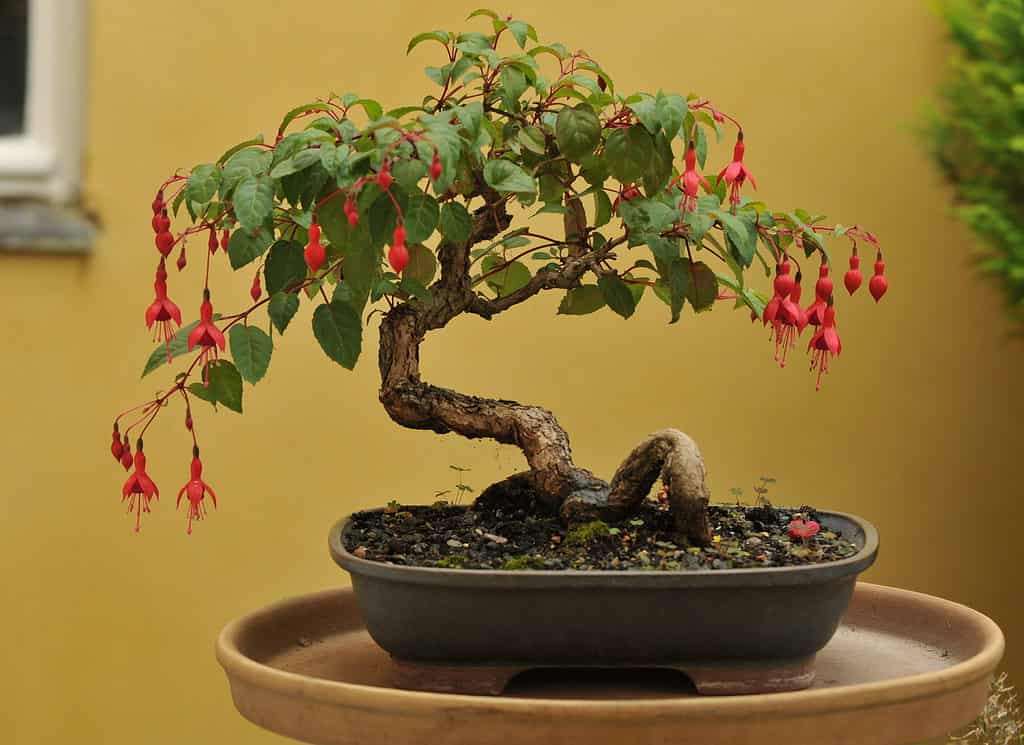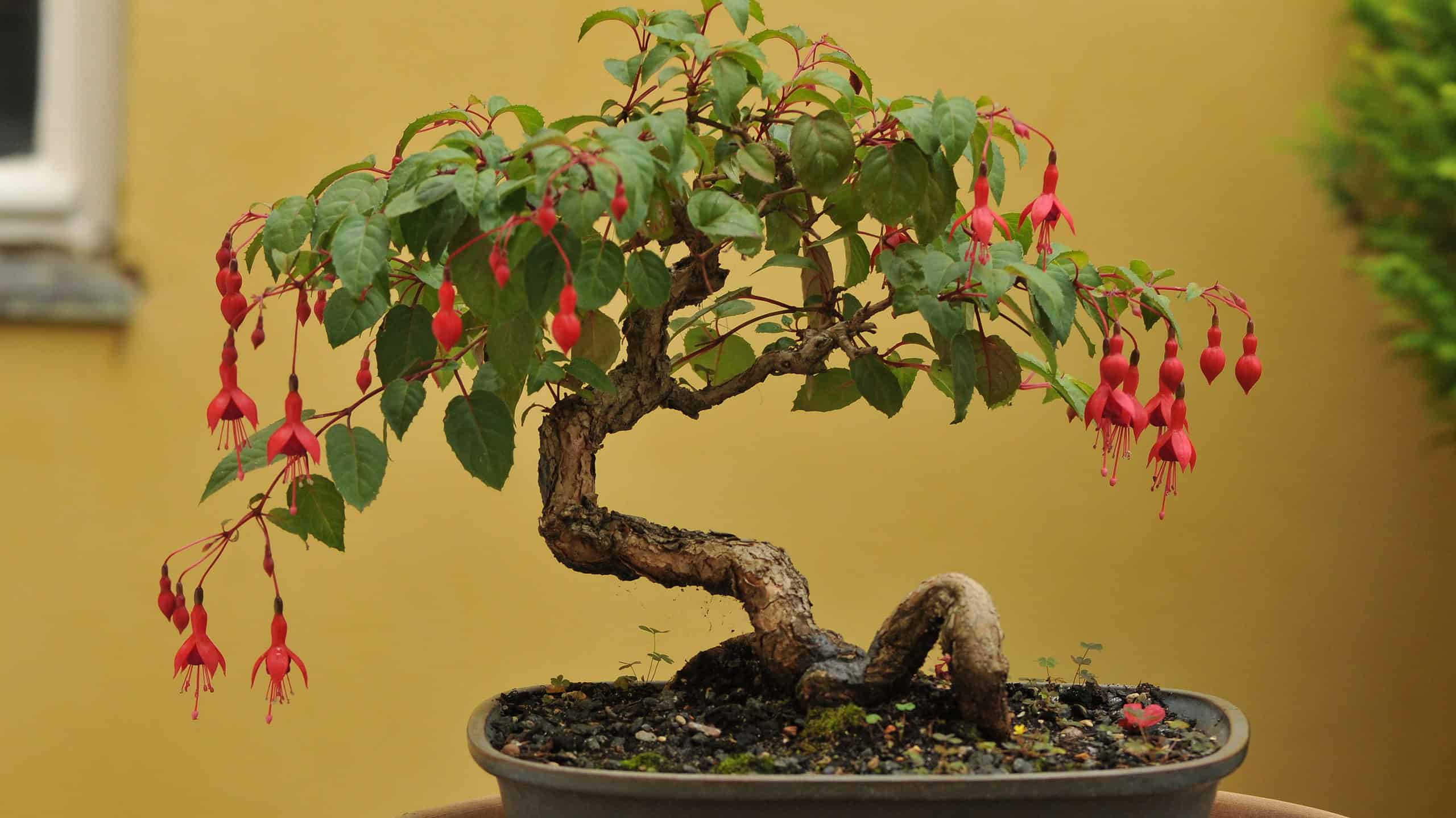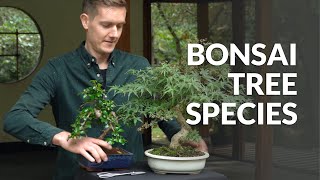Fuchsia bonsai trees need well-draining soil and consistent watering. They thrive in bright, indirect sunlight and moderate humidity.
Fuchsia bonsai trees are popular for their vibrant flowers and elegant appearance. They are relatively easy to care for, making them an excellent choice for bonsai enthusiasts of all levels. These trees require a balance of sunlight, water, and nutrients to flourish.
Place your fuchsia bonsai in a location with bright, indirect light to avoid leaf burn. Water the plant regularly but ensure the soil drains well to prevent root rot. Pruning is essential to maintain its shape and encourage growth. Fertilize every two weeks during the growing season with a balanced, water-soluble fertilizer. Proper care will reward you with a stunning, flowering bonsai tree.
Introduction To Fuchsia Bonsai
The Fuchsia bonsai tree is native to Central and South America. It is known for its vibrant and colorful flowers. The tree has a rich history in horticulture. It was first discovered in the late 17th century. The plant quickly became popular in Europe. It is named after the German botanist Leonhart Fuchs. The tree has over 100 species and countless hybrids.
The Fuchsia bonsai has a distinct look. It features hanging flowers and unique leaves. The flowers can be pink, purple, red, or white. The tree is prized for its beauty and elegance. It is suitable for indoor and outdoor gardening. Proper care ensures it thrives and blooms year-round.

Credit: a-z-animals.com
Choosing The Right Fuchsia Bonsai
Selecting the ideal Fuchsia bonsai involves considering light, watering needs, and pruning techniques. Proper care ensures vibrant blooms and healthy growth.
Popular Varieties
Fuchsia bonsai trees come in many varieties. Some popular ones include Fuchsia magellanica and Fuchsia triphylla. These types are easy to care for and look beautiful. Fuchsia magellanica has lovely red and purple flowers. Fuchsia triphylla produces pink and orange blossoms.
Selecting Healthy Plants
Always choose plants with green leaves and no spots. Check for strong stems that can support growth. Avoid plants with wilting or yellow leaves. Look for a well-developed root system. Healthy roots are white and firm. Always choose the best-looking plant for a good start.
Ideal Growing Conditions
Fuchsia bonsai trees thrive in bright, indirect sunlight and well-draining soil. Maintain moderate humidity and water consistently to keep the soil moist.
Light Requirements
Fuchsia bonsai trees need bright, indirect light. Direct sunlight can harm the leaves. Place the tree near a window with filtered light. Ensure the tree gets at least 4-6 hours of light daily. Artificial lights can also be used if natural light is insufficient.
Temperature And Humidity
The ideal temperature range is 60-75°F (15-24°C). Avoid placing the tree near drafts or heat sources. The tree thrives in moderate to high humidity. Use a humidity tray or mist the leaves daily. Dry air can cause the leaves to drop.

Credit: a-z-animals.com
Soil And Potting Mix
Ensure healthy Fuchsia Bonsai trees by using well-draining soil and a quality potting mix. A balanced blend of organic matter and perlite promotes optimal growth and prevents root rot.
Best Soil Types
Fuchsia bonsai trees love well-draining soil. A mix with peat, perlite, and pine bark works best. This helps in retaining moisture while allowing air to circulate. Avoid heavy clay soils as they retain too much water.
Potting Techniques
Choose a shallow pot with good drainage holes. This prevents waterlogging. Fill the pot with your soil mix, leaving space for the roots. Gently spread the roots out, then cover them with more soil. Press the soil down lightly to remove air pockets. Water thoroughly after potting.
Watering Practices
The Fuchsia Bonsai tree needs water frequently. Water the tree when the soil feels dry to touch. Use a watering can to pour water slowly. Make sure the water reaches the roots. Avoid letting the soil dry out completely. Overwatering can harm the tree too.
Overwatered trees may have yellow leaves. The soil might feel soggy. Roots can rot if water stays too long. Check for mold on the soil surface. Drain excess water to prevent damage. Always ensure the pot has drainage holes.

Credit: www.bonsaiempire.com
Pruning And Shaping
Remove dead or damaged branches first. This helps the tree stay healthy. Use clean, sharp tools for pruning. Cut just above a leaf node. This helps new growth. Thin out crowded areas to let light in. This helps the tree grow better.
Use wire to guide branches. Wrap the wire gently around the branch. Bend the branch slowly into shape. Remove the wire after a few weeks. This helps the branch keep its new shape. Trim back long shoots to maintain the desired form. Regular shaping keeps the bonsai looking neat.
Fertilization Strategies
Use balanced fertilizers for Fuchsia bonsai trees. These fertilizers contain equal parts of nitrogen, phosphorus, and potassium. Organic fertilizers like compost and worm castings work well. Liquid fertilizers are also a good choice. Avoid high-nitrogen fertilizers as they can harm the tree. Always read the labels for proper ratios.
Fertilize Fuchsia bonsai trees every two weeks during the growing season. Reduce fertilization to once a month in the winter. Over-fertilizing can damage the tree. Always water the tree before applying fertilizer. This helps prevent root burn. Adjust the schedule based on the tree’s health and growth.
Common Pests And Diseases
Fuchsia bonsai trees can get attacked by several pests. Some common pests are aphids, spider mites, and whiteflies. You might see tiny bugs or webs on the leaves. Leaves can turn yellow or get spots. Stunted growth is another sign. Fungal infections can also harm the tree. Look for mold or black spots on leaves. If leaves drop off, it might be a disease.
For pests, use insecticidal soap to wash the leaves. Neem oil also works well. For fungal infections, use a fungicide spray. Always remove infected leaves. Keep the area around the tree clean. Ensure good air circulation. Water the tree at the base, not on the leaves. This helps prevent mold.
Seasonal Care Tips
Fuchsia bonsai trees need special care in winter. Keep them indoors to protect from frost. Place the tree in a cool room with bright light. Water the tree sparingly, ensuring the soil is slightly dry. Avoid fertilizing during winter months. Remove any dead leaves or branches.
Fuchsia bonsai trees thrive in summer. Place them outdoors in partial shade. Water the tree daily to keep the soil moist. Fertilize every two weeks with a balanced fertilizer. Watch for pests and treat if needed. Prune the tree to maintain its shape and encourage growth.
Repotting Guidelines
Repotting ensures optimal growth for your Fuchsia Bonsai Tree. Use well-draining soil and trim roots gently. Regular repotting every two years helps maintain health and vigor.
When To Repot
Repot your Fuchsia bonsai every 2-3 years. The best time is early spring before new growth starts. Check the roots; if they circle the pot, it’s time to repot.
Step-by-step Process
First, gather your materials: a new pot, fresh soil, and pruning shears. Gently remove the tree from its current pot. Shake off old soil from the roots.
Trim any long or damaged roots. Place the tree in the new pot. Fill in with fresh soil, ensuring the tree is stable. Water the tree well after repotting. Keep it in a shaded spot for a week.
Troubleshooting Common Issues
Leaf drop can be a sign of stress. Overwatering or underwatering is often the cause. Ensure the soil is moist but not soggy. Dry soil can also cause leaves to fall. Check the humidity levels around your bonsai.
Poor flowering can be due to lack of sunlight. Fuchsia bonsai needs bright, indirect light. Ensure it gets enough light each day. Nutrient deficiency can also hinder flowering. Use a balanced fertilizer regularly. Avoid over-fertilizing as it can damage the plant.
Benefits Of Growing Fuchsia Bonsai
Fuchsia bonsai trees are very beautiful. Their flowers are colorful and charming. They brighten up any room or garden. People love their unique look. They can be the centerpiece of any space. The trees add a touch of elegance. Their tiny leaves and flowers are delightful. Fuchsia bonsai is a true work of art.
Gardening with fuchsia bonsai is relaxing. It helps reduce stress. Caring for plants can make people happy. It is a peaceful activity. Watching them grow is satisfying. The trees need gentle attention. This can calm the mind. Growing bonsai is a fun hobby. It brings joy and peace to life.
Conclusion
Caring for a Fuchsia Bonsai Tree is rewarding and enjoyable. Follow the tips mentioned for a thriving plant. Regular watering, pruning, and proper sunlight are key. With these steps, your Fuchsia Bonsai will flourish beautifully. Enjoy the process and watch your bonsai become a stunning focal point.
Happy gardening!

